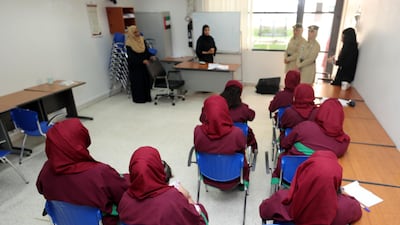Hollywood films and gritty television drama series such as Orange Is The New Black offer up a dark depiction of life behind bars.
The sense of isolation and anguish felt by female inmates that is created for the big and small screen is not, however, a reality that I find as I visit Dubai Female Prison.
As I set foot in the building, I go through regular security measures. Soon after, I am given access to the prison's yard, where dozens of inmates are going about their daily routines.
Some were dressed in red, while others wore pink uniforms.
One of the scenes that grabbed my attention was a group of inmates walking with broad smiles on their faces, sharing their life stories and joking loudly. Others queued at the prison's commissary, waiting to buy their essentials.
It is the sense of normality that may surprise those who expect an air of violent tension to permeate every square inch of the facility.
__________
Read more:
Inside Dubai Female Prison: nursery offers a brighter future to inmate mothers and children
Needs of parents in Dubai prison focus of visit
Group focuses on female prisoners
__________
What surprised me the most is the human bonds between inmates and female police officers. I look on as they chat easily, like old friends.
At around 11am, the prison yard and rooms nearby are filled with prisoners. Those in the yard take the sun, while those seated in classes are designing handmade goods.
Sharing of thoughts and views between prisoners and lecturers makes a real difference. In a lecture, women talk about how their life perspectives have changed. Some inmates are being prepared for return to the outside world, while others are keeping busy with their handicrafts and design.
Spending nearly an hour witnessing some of inmates' activities, I found that their lives were much more ordinary than I had anticipated.
In an unexpected scene, children, who were placed with their mothers, are playing in the prison's yard, while a few infants are looked after by their mothers.
A room near the yard is designated for children to draw and paint. Roughly a dozen are being taught to colour and write by a teacher. Some of those children have called the prison their home all their lives.
Staff are determined to prepare them for life in the outside world, which they must enter by the age of six in the care of extended family away from their mothers.
A separate nursery will offer these lessons – and hope of a better life for them and their mothers.

